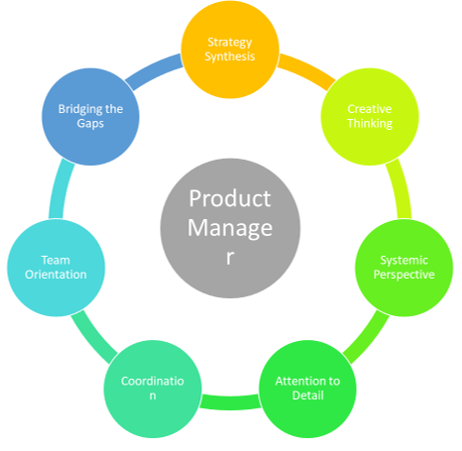The seven traits of a successful product manager outline the essential competencies to make it in product management. A product manager wears several hats and must be multi-dexterous to achieve success. In addition to the hard skills, soft competencies and inherent traits are often the difference between success and failure as a product manager.
A product manager is a quarterback of sorts or perhaps the conductor of an orchestra. Do you have most of the seven traits of a successful product manager? If not, it is time to devote the necessary time and attention to master some of the following characteristics.
So let’s first answer the question as to who is a product manager? Stratrix’s definition of a product manager is as follows:
A product manager shepherds the life cycle of a product (or service) from ideation through retirement and plays an integral role in product definition and development, packaging, pricing, positioning, promotion, and people.
The product management discipline is a hot area, and it is with reason. In recent years from highly trained technologists to newly minted ivy league MBAs, everyone is clamoring to become a product manager. To set yourself apart, you must master the seven traits of a successful product manager.
The Seven Traits of a Successful Product Manager
-
Strategy Synthesis
-
Creative Thinking
-
Systemic Perspective
-
Attention to Detail
-
Coordination
-
Team Orientation
-
Bridging the Gaps
 Let us delve into each of these seven product management success traits.
Let us delve into each of these seven product management success traits.
Strategy Synthesis:
Strategy synthesis is the fountainhead of the seven traits a product manager must acquire and master.
While a senior product management executive may be a part of helping define corporate/business strategy, a typical product manager is a bit removed, except perhaps providing inputs at a product or a product portfolio level.
Understanding the corporate/business strategy and synthesizing the impact at a product/portfolio level is a vital competency. The reason is that product management exists to support the vision, mission, goals, and strategy of the company. Strategy synthesis, interpretation, and elaboration are critical success factors.
Within the parameters of business strategy, the product manager owns the domain of product strategy. A product strategy that is in sync with the overall business strategy is a foundation of a successful enterprise.
Creative Thinking:
As much as product management is a process, it is also an art. Me-too products clutter and litter the landscape of product management. To raise above the herd and make a mark, a product manager must be a creative thinker and be able to come up with out-of-the-box ideas to distinguish their product in the marketplace.
A traditional product owner might have come up with a thinner version of a flip phone. But Steve Jobs, the ultimate icon of product management, came up with the concept of a touch-enabled smartphone. As they say, the rest is history. Product managers who are iconoclasts and creative thinkers move the needle and scale new heights.
Systemic Perspective:
Today, we live in an interconnected economic and business ecosystem. A product exists within the broader context. So, a systemic perspective that looks at the big picture – both within and outside the firm – is a fundamental competency a product manager must possess. A systemic perspective leads to better conceptualization, definition, development, launch, and management of products that will limit inward thinking and myopia.
Attention to Detail:
Building and launching a product is akin to building a home. While the pretty designs are what attract the homeowners, the end result requires a million small things to come together – from structural integrity to plumbing to painting to interior design. That is what turns the abstraction of a house into a home. Any missing piece will necessitate repairs and worse.
Similarly, a product is an agglomeration of a thousand steps and dozens of people and processes. Vision alone is not enough, and flawless execution often is the difference between failure and pinnacle.
A product manager must pay excruciating attention to detail all through the product lifecycle.
Coordination:
Product management is not an island and an isolated discipline. A product manager is, in essence, a project manager as well – one who manages a multi-dimensional project called the “Product.”
A product manager may receive and provide inputs, but they are reliant on many other specialized functions within the enterprise. For example, R&D is the purview of scientists, IT is the domain of technologists, marketing is the place for creative mavericks, and relationship mavens dominate the sales sphere. But a product manager has to interact, interface, and integrate all of their work and encapsulate into the product.
This coordination skill is similar to how a maestro may conduct a symphony, or a quarterback directs troupes on the field.
Team Orientation:
While the world knows of brilliant mavericks who envision and launch pathbreaking products, the truth is product management is a team sport. Even the most excellent product visionaries have to rely on others. (For example, Steve Jobs’s vision is made real by the design genius of Jony Ive.)
A product manager must manage their own team and also imbue the spirit of a team into the larger group of people who must blend their diverse talents and synthesize them into a symphony and let not let it devolve into cacophony.
The team orientation does not stop within the walls of the enterprise, either. Suppliers, partners, distributors, beta testers, analysts, and influencers often form a robust ecosystem to draw inspiration, test out hypotheses, and seek assistance.
Bridging the Gaps:
Last but perhaps most important of the habits of a successful product manager is the ability to bridge the gaps and be a glue that binds things together.
Often, the product manager is the translator between different functions who see things only from their vantage point. For example, a security expert may focus on the best application and cybersecurity. A marketing person may only think of creative execution. In all these cases, there is a risk of local optimization and global sub-optimization.
A product manager needs to be the judge of what’s best within the context of the product and bridge the strategy gaps, perception gaps, communication gaps, and execution gaps.
There you have it – the seven habits of successful product manager. Which of the seven traits of a successful product manager do you possess? What missing competencies would you like to work towards?
Are we missing any characteristics and competencies that make a product manager tick? If so, please feel free to share your thoughts and ideas with the rest of the Stratrix community.
If you are a product manager, please consider Stratrix’ product management strategy templates


